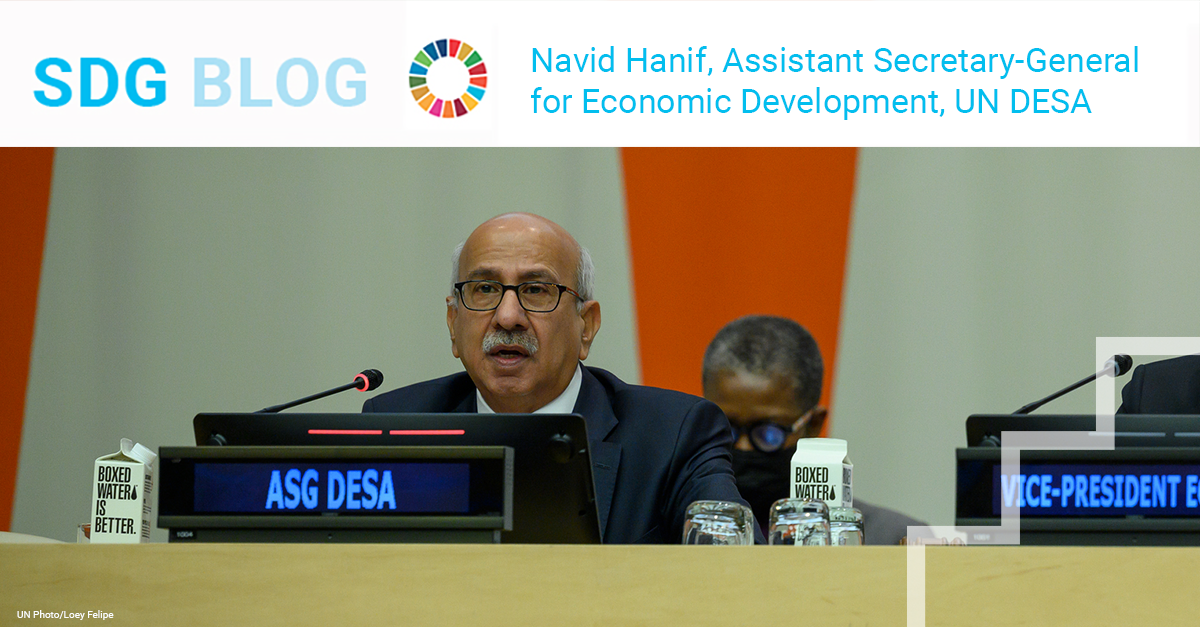SDG Blog

We must secure financing to prevent a sustainable development divide
By Navid Hanif, Assistant Secretary-General for Economic Development
Our world is experiencing unprecedented multifaceted crises that threaten the implementation of the Addis Ababa Action Agenda. Many developing countries are still coping with the scarring effects of the COVID-19 pandemic making their economies recover at a very slow pace. While the war in Ukraine poses a serious threat to global peace and security, it also caused a significant increase in food and energy prices that are unsustainable for the most vulnerable populations around the world.
Climate change has increased the frequency of natural disasters and is imposing a great toll on the most vulnerable countries whose financing needs keep growing. These compounding effects led to the tightening of the global financial system, meaning that money has become more expensive to obtain for firms, governments, and households. As a result, the financing gap for the Sustainable Development Goals (SDGs) keeps widening.
The forthcoming 2023 Financing for Sustainable Development Report emphasizes that development prospects continue to diverge due to uneven financing capacities between developed and developing countries. Developing countries face unsustainable debt burdens and have a narrow margin of maneuver to finance development projects and social protection systems simultaneously, in large part due to an inefficient international financial system.
As an illustration, even before the recent increase in interest rates, least developed countries had to pay from 5 to 8 per cent interest rates to borrow from international financial markets, while many developed countries only paid 1 per cent. In fact, some studies show that most countries that experienced severe debt crises in the past could have been solvent if they had a continuous access to low interest rate financing.
The report further stresses that unless we take immediate action, this “finance divide” will soon translate into a lasting “sustainable development divide” and many developing countries may not achieve the SDGs, including their sustainable industrial transformation.
Financing for sustainable development has never been as important and urgent as it is now. To ensure that more humans around the world live a decent life, it is necessary to scale-up SDG investment by increasing international development cooperation and improving multilateral processes and undertaking important reforms to global economic governance and international financial architecture.
It is precisely to bridge this gap that the UN Secretary-General called for an SDG Stimulus in February 2023. This initiative aims to offset the major setback on SDG progress by creating a favourable and enabling economic and social environment. The Stimulus calls for a significant increase in financing for sustainable development, reaching between $500 billion and $1 trillion at the bare minimum by 2025, and puts forward three areas for immediate action:
- Explore solutions to reduce the high cost of debt and lower the rising risks of debt distress, including by converting short-term high interest borrowing into long-term (more than 30 years) debt at lower interest rates.
- Significantly increase affordable long-term financing alternatives for development, especially through strengthening and improving the terms of lending by multilateral development banks (MDBs), and by aligning all financing flows with the SDGs.
- Expand contingency financing to countries in need, including by integrating disaster and pandemic clauses into all lending instruments, and exploring how Special Drawing Rights can finance climate mitigation and be automatically issued in times of crisis.
Today’s economic realities require a new global institutional arrangement that better address developing countries’ immediate needs. A profound reform of the current international financial architecture that goes beyond existing international financial institutions’ mandates is sorely needed. Global financial safety nets need to be expanded, sovereign debt restructuring mechanisms must become more efficient, and MDBs and public development banks should play a more important role in financing for sustainable development.
We are at a crossroads and this year’s ECOSOC Financing for Development (FfD) Forum, that will take place on 17-20 April, will be of particular importance. All stakeholders need to come together to bring long-term and long-lasting solutions to solve financing for development challenges. The FfD Forum’s outcome will provide the basis for high-level discussions on financing for development at the High-Level Political Forum, the SDG Summit, the General Assembly High-level Dialogue on Financing for Development, the ministerial conference on the Summit of the Future and potential first edition of the Biennial Summit between the G20, ECOSOC, the Secretary-General, and the heads of the international financial institutions in 2024. These events will build up to a possible 4th Financing for Development Conference, which Member States decided to consider convening in 2025.
 Welcome to the United Nations
Welcome to the United Nations